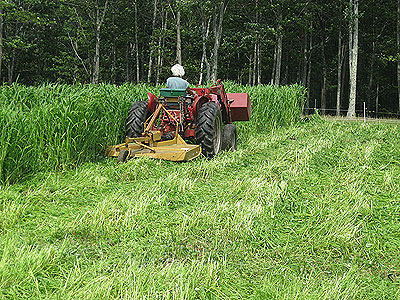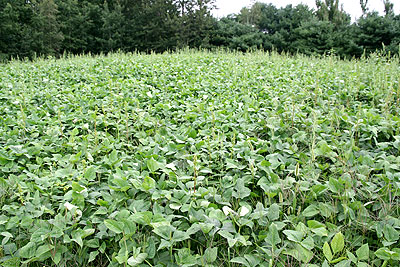 |
| The author mows down a crop of Japanese millet. Becky Sideman photo. |
By Eric Sideman, Ph.D.
People often ask me, “What is the best green manure?” That sets me off on one of my favorite lectures. “There is no best green manure,” I begin, and go on to explain that green manures (cover crops) have many benefits, and farms and gardens have many windows of opportunity where they can fit. So the goal is to figure out which benefit is most important at that time, which green manure best offers that benefit while matching your window, and which also suits your equipment.
Summer often offers a good window to use a green manure to beat back some weeds, add some organic matter, add some nitrogen or break a disease cycle by growing a crop that is not a host for that disease. This opportunity may occur after you harvest all the peas, or it may be part of a long sequence of green manures you are using to prepare new ground. In any case, be smart with bare ground: Don’t let land succumb to weeds or erosion; don’t watch soil structure degrade when instead you could be building or maintaining its productive value.
Here are some cover crops that can be used between the last frost of spring and the first of fall.
To Add Organic Matter
Summer is the best season for growth of green manures that build a lot of organic matter and thus fix some carbon into the soil system. Japanese millet and sorghum-sudan grass both grow quickly and form vast amounts of biomass – so much organic matter that without good equipment, they may not be the crop for you. They are quite tolerant of soil types and variable pH and are often used to reclaim worn out land, but to get good production out of them, you need to provide fertility. Applying manure before planting is good for these crops and a good way to get manure into the system. One way of avoiding having to deal with 8-foot or taller plants is to mow them when they are 2 to 4 feet tall and let them regrow. Both of these crops shade and compete strongly with weeds, although some weeds still survive in the shade. (See below for more on weeds.)
To Add Nitrogen
Nitrogen (N) is the nutrient that most commonly limits crop growth. Sources of N for organic growers are expensive and often difficult to spread on the field. And, with concern about the potential for excess phosphorus (P) to pollute surface water, growers increasingly appreciate N sources that contain no P. The worst case of P pollution arises from growers using compost or manure for N. After years of meeting the N needs of crops with these, P levels in soil can get sky high. For the best N source that adds zero P, grow a legume green manure. Legumes live symbiotically with some species of bacteria that take N from the air and fix it into biological compounds. When these compounds degrade, they add N to the soil in a form that subsequent crops can use.
The two best legumes that grow well in the summer are soybeans and cow peas. These heat-loving crops can tolerate dry periods in the summer (cow peas being more drought tolerant). They are quick growing and compete with weeds, although again, some weeds get by in the shade. (See below for more on weeds.) In a good season, these summer cover crops can fix well over 100 pounds of N per acre. They are easy to mow and handle with light equipment. Take them down as the season cools, because once the warm days wane, their production drops dramatically. Be sure to plant a fall cover to catch all the N they fixed.
 |
| An example of the wrong cover crop for the particular situation – or a crop that should have been mowed by this time. The cover crop is cow peas, but the field has considerable pigweed also – going to seed. Eric Sideman photo. |
Weed Management with Cover Crops
Cover crops may shade and compete well with weeds, but few weeds actually die because they are shaded. Seeds may not germinate, or the weeds may grow slowly and set fewer new seeds, but rarely will the weed die. Managing the cover crop is what really reduces weed problems on farms or in gardens. Cultivation kills weeds: It prompts weed seeds to germinate, and then you can kill them with more cultivation, thus reducing the number of seeds in the weed seed bank.
The trick to using cover crops to manage weeds is timing. Preparing the ground for planting the cover crop will prompt weed seeds to germinate. You may want to till or disc a few times before actually planting the cover to prompt more seeds to germinate and to kill them and reduce that seed bank more. Most important is to watch the cover crop grow and watch the weeds growing with it, and mow or till under the crop before any weeds have viable seeds. One way to accomplish this is to plant two short-season cover crops during the summer, followed by a fallow period of tilling, and then plant a fall cover.
The key to using cover crops to manage weeds is timing the fallow periods and the tilling to match the time when common weeds on your farm or garden germinate or grow well. For example, if your most common weed is quackgrass, then fallow periods with tilling to beat it back in the spring and fall when it grows best are good; grow a summer cover crop between these fallow periods to build and maintain the soil. In this case you could grow millet or cowpeas all summer, because quackgrass won’t grow well then.
On the other hand, if your common weeds are summer weeds, such as pigweed, then growing cowpeas all summer will not solve the problem. In fact, it will probably worsen, as the pigweed will grow right along with the cowpeas and set thousands of new seeds. In this situation, buckwheat may be the cover crop of choice. Buckwheat is a short season crop. You can time its planting so that lots of pigweed may grow with it; just be sure to till in the crop (and the pigweed) before any pigweed sets viable seeds. Because buckwheat grows quickly, you will have time to do this twice in the same summer. Buckwheat seed is cheap, the crop is quite competitive and will shade weeds, keeping them growing slowly; but buckwheat has very little organic matter, so its main benefit is short season cover between tillage operations that kill weeds.
There is a lot more to using cover crops. Here are a few references that discuss timing, prime benefit, seeding rates, dates, etc., for lots of covers.
Using Green Manures (A MOFGA fact sheet) www.mofga.orghttps://www.mofga.org/wp-content/uploads/2021/01/FS 10 Green Manures web.pdf
Managing Cover Crops Profitably (A Sustainable Agriculture Network publication) – free download or order a print copy at www.sare.org/Learning-Center/Books/Managing-Cover-Crops-Profitably-3rd-Edition
Northeast Cover Crop Handbook, by Marianne Sarrantonio (My favorite cover crop book; still available from retailers)
Eric Sideman is MOFGA’s organic crop specialist. You can contact him with your questions at [email protected] or 568-4142.
